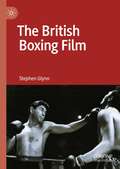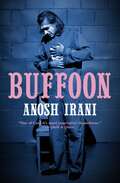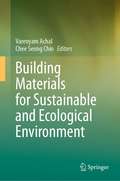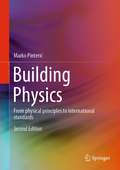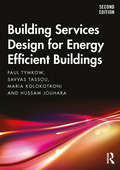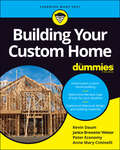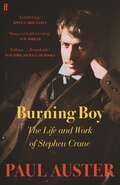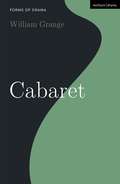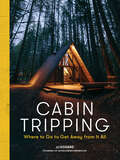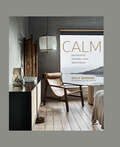- Table View
- List View
Britain’s Toy Car Wars: The War of Wheels Between Dinky, Corgi and Matchbox
by Giles ChapmanFor fifty years, Britain made the best toy cars in the world, expertly shrinking every kind of reallife vehicle and producing them in their countless, die-cast millions. Dinky Toys were the 1930s pioneers, then in the 1950s came the pocket-money Matchbox series, followed by Corgi Toys bristling with ingenious features and movie stardust. But who were the driving forces behind this phenomenon? And how did they keep putting the latest, most exciting cars into the palm of your hand year after year? In this illustrated and expanded edition of Britain’s Toy Car Wars, Giles Chapman reveals the extraordinary battle to dominate Britain’s toy car industry, and the dramas and disasters that finally saw the tiny wheels come off …
British Art and the Environment: Changes, Challenges, and Responses Since the Industrial Revolution (British Art: Histories and Interpretations since 1700)
by Charlotte Gould Sophie MesplèdeThis book explores the nature of Britain-based artists’ engagement with the transformations of their environment since the early days of the Industrial Revolution. At a time of pressing ecological concerns, the international group of contributors provide a series of case studies that reconsider the nature–culture divide and aim at identifying the contours of a national narrative that stretches from enclosed lands to rising seas. By adopting a longer historical view, this book hopes to enrich current debates concerning art’s engagement with recording and questioning the impact of human activity on the environment. The book will be of interest to scholars working in art history, contemporary art, environmental humanities, and British studies.
British Art and the Environment: Changes, Challenges, and Responses Since the Industrial Revolution (British Art: Histories and Interpretations since 1700)
by Charlotte Gould; Sophie MesplèdeThis book explores the nature of Britain-based artists’ engagement with the transformations of their environment since the early days of the Industrial Revolution. At a time of pressing ecological concerns, the international group of contributors provide a series of case studies that reconsider the nature–culture divide and aim at identifying the contours of a national narrative that stretches from enclosed lands to rising seas. By adopting a longer historical view, this book hopes to enrich current debates concerning art’s engagement with recording and questioning the impact of human activity on the environment. The book will be of interest to scholars working in art history, contemporary art, environmental humanities, and British studies.
The British Boxing Film
by Stephen GlynnThis book constitutes the first full volume dedicated to an academic analysis of the sport of boxing as depicted in British film. Through close textual analysis, production and reception histories and readings that establish social, cultural and political contexts, the book explores the ways in which prizefighters, amateur boxers, managers and supporters (from Regency gentry to East End gangsters) are represented on the British screen. Exploring a complex and controversial sport, it addresses not only the pain-versus-reward dilemma that boxing necessarily engenders, but also the frequently censorious attitude of those in authority, with boxing’s social development facilitating a wider study around issues of class, gender and race, latterly contesting the whole notion of ‘Britishness’. Varying in scope from Northern circuit comedies to London-based ‘ladsploitation’ films, from auteur entries by Alfred Hitchcock to programme fillers by E.J. Fancey, the boxing film also serves as a prism through which one can trace major historical shifts in the British film industry.
The British Film Industry in 25 Careers: The Mavericks, Visionaries and Outsiders Who Shaped British Cinema
by Geoffrey MacnabThe British Film Industry in 25 Careers tells the history of the British film industry from an unusual perspective - that of various mavericks, visionaries and outsiders who, often against considerable odds, have become successful producers, distributors, writers, directors, editors, props masters, publicists, special effects technicians, talent scouts, stars and, sometimes, even moguls. Some, such as Richard Attenborough and David Puttnam, are well-known names. Others, such as the screenwriter and editor Alma Reville, also known as Mrs Alfred Hitchcock; Constance Smith, the 'lost star' of British cinema, or the producer Betty Box and her director sister Muriel, are far less well known. What they all have in common, though, is that they found their own pathways into the British film business, overcoming barriers of nationality, race, class and gender to do so.Counterpointing the essays on historical figures are interviews with contemporaries including the director Amma Asante, the writer and filmmaker Julian Fellowes, artist and director Isaac Julien, novelist and screenwriter Hanif Kureishi, and media entrepreneur Efe Cakarel, founder of the online film platform MUBI, who've come into today's industry, adjusting to an era in which production and releasing models are changing – and in which films are distributed digitally as well as theatrically.
Brotherhood in Rhythm: The Jazz Tap Dancing of the Nicholas Brothers, 20th Anniversary Edition
by Constance Valis HillWhen the Nicholas Brothers danced, uptown at the Cotton Club, downtown at the Roxy, in segregated movie theatres in the South, and dance halls across the country, audiences cheered, clapped, stomped their feet, and shouted out uncontrollably. Their exuberant style of American theatrical dance--a melding of jazz, tap, acrobatics, black vernacular dance, and witty repartee--was dazzling. Though daredevil flips, slides, and hair-raising splits made them show-stoppers, the Nicholas Brothers were also highly sophisticated dancers who refined a centuries-old tradition of percussive dance into the rhythmic brilliance of jazz tap. In Brotherhood in Rhythm, author Constance Valis Hill interweaves an intimate portrait of these great performers with a richly detailed history of jazz music and jazz dance, both bringing their act to life and explaining their significance through a colourful analysis of their eloquent footwork, their full-bodied expressiveness, and their changing style. Hill vividly captures their soaring careers, from the Cotton Club appearances with Duke Ellington, Cab Calloway, and Jimmy Lunceford, to film-stealing big-screen performances with Chick Webb, Tommy Dorsey, and Glenn Miller. Drawing on a deep well of research and endless hours of interviews with the Nicholas brothers themselves, she also documents their struggles against the nets of racism and segregation that constantly enmeshed their careers and denied them the recognition they deserved. More than a biography of two immensely talented but underappreciated performers, Brotherhood in Rhythm offers a profound understanding of this distinctively American art and its intricate links to the history of jazz.
Brückenbau beginnt im Kopf: Ingenieursein - mehr als technische Lösungen
by Moritz MengeBauingenieur zu sein ist ein erfüllender Beruf. Bauingenieure gestalten nachhaltige Infrastruktur. Wir errichten Häuser, Straßen, Brücken, Tunnel, Kulturstätten, Türme und vieles mehr. Dafür bringen wir häufig die ganze Ingenieurskunst auf, um solide Lösungen zu erreichen. Und häufig noch mehr, was jenseits der technischen Ingenieurskunst liegt. Das Buch schaut über die technischen Lösungen hinaus in das weitere Umfeld des Bauingenieurs und reflektiert seinen Beruf und die eigene Einstellung aus unterschiedlichsten Perspektiven. „Brückenbau beginnt im Kopf“ bedeutet, sich darauf einzulassen, Verbindungen zu suchen – zu einem ganzheitlichen Berufsbild und seinem Standort als Ingenieur. Wenn der sichere Brückenschlag zum Umfeld des Ingenieurs gelingt, heißt Ingenieursein mehr als perfekte Technik anzuwenden.
Buffoon
by Anosh IraniThree-time Governor General’s Literary Award–shortlisted author and playwright Anosh Irani’s critically acclaimed one-man show Buffoon is a masterclass of tragicomic theatre. Born to circus folk who prefer trapezing over parenting, Felix quickly learns to turn life’s misfortunes into jokes. His longing for family and home is piqued at the tender age of seven when he falls hopelessly in love with an older woman, the beguiling Aja, who is eight. In the process, a clown is born, and we watch him grow into a middle-aged buffoon. Over time, Felix stops waiting for someone else to love him; his journey becomes one of loving himself. A story of love, loss, and the fate that binds us, Buffoon is a gut-wrenching one-man show that expertly walks the tightrope between heartbreak and hilarity.
Building Codes Illustrated: A Guide to Understanding the 2021 International Building Code (Building Codes Illustrated)
by Francis D. Ching Steven R. WinkelBUILDING CODES ILLUSTRATED STAY INFORMED OF THE LATEST UPDATES TO THE INTERNATIONAL BUILDING CODE WITH THE LEADING VISUAL REFERENCE In the newly revised Seventh Edition of Building Codes Illustrated: A Guide to Understanding the 2021 International Building Code®, architectural drawing expert Francis D.K. Ching and well known architect Steven R. Winkel deliver a beautifully illustrated and intuitively written handbook for the 2021 International Building Code (IBC). The authors provide brand new chapters on plumbing fixture counts, elevators, special construction, and existing buildings while updating the remainder of the material to align with recent changes to the IBC. Easy to navigate and perfect as a quick-reference guide to the IBC, Building Codes Illustrated is a valuable visual resource for emerging professionals. The book also includes: Thorough introductions to navigating the Code, use and occupancy, special uses and occupancies, and building heights and areas Full explorations of the types of construction, fire resistive construction, interior finishes, fire-protection systems, and means of egress Practical discussions of accessibility, interior environment, exterior walls, roof assemblies, and structural provisions In-depth examinations of special inspections and tests, soils and foundations, building materials and systems, and elevators Perfect for students of architecture, interior design, construction, and engineering, the latest edition of Building Codes Illustrated is also ideal for professionals in these fields seeking an up-to-date reference on the 2021 International Building Code.
Building Codes Illustrated: A Guide to Understanding the 2021 International Building Code (Building Codes Illustrated)
by Francis D. Ching Steven R. WinkelBUILDING CODES ILLUSTRATED STAY INFORMED OF THE LATEST UPDATES TO THE INTERNATIONAL BUILDING CODE WITH THE LEADING VISUAL REFERENCE In the newly revised Seventh Edition of Building Codes Illustrated: A Guide to Understanding the 2021 International Building Code®, architectural drawing expert Francis D.K. Ching and well known architect Steven R. Winkel deliver a beautifully illustrated and intuitively written handbook for the 2021 International Building Code (IBC). The authors provide brand new chapters on plumbing fixture counts, elevators, special construction, and existing buildings while updating the remainder of the material to align with recent changes to the IBC. Easy to navigate and perfect as a quick-reference guide to the IBC, Building Codes Illustrated is a valuable visual resource for emerging professionals. The book also includes: Thorough introductions to navigating the Code, use and occupancy, special uses and occupancies, and building heights and areas Full explorations of the types of construction, fire resistive construction, interior finishes, fire-protection systems, and means of egress Practical discussions of accessibility, interior environment, exterior walls, roof assemblies, and structural provisions In-depth examinations of special inspections and tests, soils and foundations, building materials and systems, and elevators Perfect for students of architecture, interior design, construction, and engineering, the latest edition of Building Codes Illustrated is also ideal for professionals in these fields seeking an up-to-date reference on the 2021 International Building Code.
Building Materials for Sustainable and Ecological Environment
by Varenyam Achal Chee Seong ChinThis book uses theories, hypotheses, policies, practical insights and case studies to introduce and elucidate green building materials for sustainable construction. Cement is the most widely used building material in construction; however, it is not sustainable, being responsible for 7% of global carbon dioxide emissions and consuming huge quantities of energy. In order to limit the ecological damage, sustainable building materials are needed. Ecosystems are a source of important lessons and models for transitioning the built environment onto a sustainable path that opens options for sustainable building material in construction. The book provides a guide for readers seeking knowledge on sustainable building materials with the potential to lower environmental impact by reducing CO2 emission throughout the building’s lifecycle. The book is motivated by recent rapid advances in sustainable building materials production, including green building materials made of industrial by-products and recycled wastes, earth materials, plant-based materials, microbial-based materials or supplementary cementitious materials, to reduce the environmental impacts of traditional building materials. Discussing the development and applications of various sustainable building materials, including related case studies, and addressing the environmental issue with a holistic and systematic approach that creates an ecology of construction for sustainability in infrastructures, it offers promising solutions to achieve renewable and sustainable building materials for the future.
Building Physics: From physical principles to international standards
by Marko PinterićThis book offers a comprehensive presentation of the most important phenomena in building physics: heat transfer, moisture/humidity, sound/acoustics and illumination. As the book is primarily aimed at engineers, it addresses technical issues with the necessary pragmatism and incorporates many practical examples and related international standards. In order to ensure a complete understanding, it also explains the underlying physical principles and relates them to practical aspects in a simple and clear manner. The relationships between the various phenomena of building physics are clarified through consistent cross-referencing of formulas and ideas. The second edition features both new and revised sections on topics such as energy balance, solar gain, ventilation, road traffic and daylighting and takes into account new developments in international standards. It newly features almost 200 illustrations and 21 videos worth of supplementary material. The book is primarily aimed at students of civil engineering and architecture, as well as scientists and practitioners in these fields who wish to deepen or broaden their knowledge of topics within building physics.
Building Services Design for Energy Efficient Buildings
by Paul Tymkow Savvas Tassou Maria Kolokotroni Hussam JouharaThe role and influence of building services engineers are undergoing rapid change and are pivotal to achieving low-carbon buildings. However, textbooks in the field have tended to remain fairly traditional with a detailed focus on the technicalities of heating, ventilation and air-conditioning (HVAC) systems, often with little wider context. This book addresses that need by embracing a contemporary understanding of the challenge to address climate change, together with practical approaches to energy efficiency and carbon mitigation for mechanical and electrical systems, in a concise manner. The essential conceptual design issues for planning the principal building services systems that influence energy efficiency are examined in detail. These are HVAC and electrical systems. In addition, the following issues are addressed: background issues on climate change, whole-life performance and design collaboration generic strategies for energy efficient, low-carbon design health & wellbeing and post-occupancy evaluation building ventilation air-conditioning and HVAC system selection thermal energy generation and distribution systems low-energy approaches for thermal control electrical systems, data collection, controls and monitoring building thermal load assessment building electric power load assessment space planning and design integration with other disciplines. In order to deliver buildings that help to mitigate climate change impacts, a new perspective is required for building services engineers, from the initial conceptual design and throughout the design collaboration with other disciplines. This book provides a contemporary introduction and guide to this new approach, for students and practitioners alike.
Building Services Design for Energy Efficient Buildings
by Paul Tymkow Savvas Tassou Maria Kolokotroni Hussam JouharaThe role and influence of building services engineers are undergoing rapid change and are pivotal to achieving low-carbon buildings. However, textbooks in the field have tended to remain fairly traditional with a detailed focus on the technicalities of heating, ventilation and air-conditioning (HVAC) systems, often with little wider context. This book addresses that need by embracing a contemporary understanding of the challenge to address climate change, together with practical approaches to energy efficiency and carbon mitigation for mechanical and electrical systems, in a concise manner. The essential conceptual design issues for planning the principal building services systems that influence energy efficiency are examined in detail. These are HVAC and electrical systems. In addition, the following issues are addressed: background issues on climate change, whole-life performance and design collaboration generic strategies for energy efficient, low-carbon design health & wellbeing and post-occupancy evaluation building ventilation air-conditioning and HVAC system selection thermal energy generation and distribution systems low-energy approaches for thermal control electrical systems, data collection, controls and monitoring building thermal load assessment building electric power load assessment space planning and design integration with other disciplines. In order to deliver buildings that help to mitigate climate change impacts, a new perspective is required for building services engineers, from the initial conceptual design and throughout the design collaboration with other disciplines. This book provides a contemporary introduction and guide to this new approach, for students and practitioners alike.
Building Surveyor’s Pocket Book (Routledge Pocket Books)
by Melanie Smith Christopher GorseBuilding Surveyor’s Pocket Book is an accessible encyclopaedia of matters vital to building surveyors. Well-illustrated with diagrams, pictures, tables, and graphs, it covers all essential elements of building pathology, building performance, and building construction terminology in a simple, accessible way for the practitioner and student. This Pocket Book provides a practical and portable reference text, working as a first-stop publication for those wishing to refresh their knowledge or in need of guidance on surveying practice. Working through fundamental principles in key practice areas, the book is not overly bound by the regulation and legislation of one region, and the principles can be applied internationally. This book is ideal reading for individual surveyors, practitioners, and students in building surveying, facilities management, refurbishment, maintenance, renovation, and services management. It is also of use for those interested in building forensics, building performance, pathology, and anyone studying for their RICS APC. Many other professions in architecture, contracting, engineering, and safety will also find the book of use when undertaking similar practice.
Building Surveyor’s Pocket Book (Routledge Pocket Books)
by Melanie Smith Christopher GorseBuilding Surveyor’s Pocket Book is an accessible encyclopaedia of matters vital to building surveyors. Well-illustrated with diagrams, pictures, tables, and graphs, it covers all essential elements of building pathology, building performance, and building construction terminology in a simple, accessible way for the practitioner and student. This Pocket Book provides a practical and portable reference text, working as a first-stop publication for those wishing to refresh their knowledge or in need of guidance on surveying practice. Working through fundamental principles in key practice areas, the book is not overly bound by the regulation and legislation of one region, and the principles can be applied internationally. This book is ideal reading for individual surveyors, practitioners, and students in building surveying, facilities management, refurbishment, maintenance, renovation, and services management. It is also of use for those interested in building forensics, building performance, pathology, and anyone studying for their RICS APC. Many other professions in architecture, contracting, engineering, and safety will also find the book of use when undertaking similar practice.
Building Time: Architecture, event, and experience
by David LeatherbarrowWhile most books on architecture concentrate on spatial themes, this book explores architecture's temporal dimensions. Through a series of close readings of buildings, both contemporary and classic, it demonstrates the centrality of time in modern architecture, and shows why an understanding of time is critical to understanding good architecture.All buildings exist in time. Even if designed for permanence, they change, slowly but inevitably. They change use, they accrue history and meaning, they decay – all of these processes are inscribed in time. So too is the path traced by the sun through a building, and the movements of the human body from room to room. Time, this book argues, is the framework for our spatial experience of architecture, and a key dimension of a building's structure and significance. Building Time presents twelve close readings of buildings and artworks which explore this idea. Examining works by distinctive modern architects – from Eileen Gray to Álvaro Siza and Wang Shu – it takes the reader, in some cases literally step-by-step, through a built work, and provides insightful reflections on the importance of 'making space for time' in architectural design.This is a book for both theorists and for architectural designers. Through it, theorists will find a way to rethink the fundamental premises and aims of design work, while designers will rediscover the order and ideas that shape the world around them-its buildings, interiors, and landscapes.
Building Your Custom Home For Dummies
by Kevin Daum Janice Brewster Peter Economy Anne Mary CiminelliBuild a place you’ll love to come home to Why settle for a house that looks like every other one in the neighborhood? With Building Your Custom Home For Dummies on your desk (right alongside those inspiring architecture magazines), you can design and build the home of your dreams. From brainstorming must-have features to hanging a wreath on the front door, this book walks you through what you need to know from start to finish. Get savvy on purchasing property, securing financing, and raising the walls that will become the setting for life’s next chapter. If you can imagine it, you can build it! Inside… Locate your ideal building site Hire an architecture and contracting team you can trust Finance smoothly and manage your construction budget Discover new green building techniques Oversee construction from A to Z Furnish, landscape, and maintain your property
Building Your Custom Home For Dummies
by Kevin Daum Janice Brewster Peter Economy Anne Mary CiminelliBuild a place you’ll love to come home to Why settle for a house that looks like every other one in the neighborhood? With Building Your Custom Home For Dummies on your desk (right alongside those inspiring architecture magazines), you can design and build the home of your dreams. From brainstorming must-have features to hanging a wreath on the front door, this book walks you through what you need to know from start to finish. Get savvy on purchasing property, securing financing, and raising the walls that will become the setting for life’s next chapter. If you can imagine it, you can build it! Inside… Locate your ideal building site Hire an architecture and contracting team you can trust Finance smoothly and manage your construction budget Discover new green building techniques Oversee construction from A to Z Furnish, landscape, and maintain your property
Burning Boy: The Life and Work of Stephen Crane
by Paul AusterPaul Auster takes the reader on a vivid journey through the brief 29 years of Stephen Crane's life. Auster analyses the major works with such enthusiasm that the reader immediately wants to read Crane's work.Auster also brings to life the world of fin de siecle America as the 19th century ends and the 20th is beginning.This pulsating world is the background to a life lived at a fever pitch - in war zones, near-drowning on his way to the Spanish American War, as well involvement in a scandalous love affair that caused him to leave the country.Crane died in 1900, but he is not the last of the Victorians, he is the first of the Moderns.
Cabaret (Forms of Drama)
by William GrangeWhere did cabaret come from? What has it got to do with pre-war Berlin, decadent society and Nazis? How does it turn into media cabaret and the sisterhood of sleaze? Is cabaret a primary vehicle for exploring the range of sexual practices and alternative sexual identities?In this new book William Grange brings into one place for the first time the range of practices now associated with the form of cabaret. Beginning with its origins in speciality German theatres and the development both of the sheet music industry and disc recordings, Grange tracks the form through into its golden age in the 1920s and beyond.The book's three sections deal first with the emergence of Berlin as the 'German Chicago', where cabaret flourished in the midst of post-war political turmoil. The abolition of censorship allowed nude dancing and sexually explicit songs and routines. It also saw the introduction of kick-line dancing and black performers. In the book's second and third sections Grange takes the story forward into the post second-world-war world, describing how the form moved outwards from central Europe to move across the whole world, reaching Singapore and Australia, and as it did so settling into the range of forms in which we know it today. Some of these forms became 'media cabaret' looking towards the new media age, the postmodernism that followed on from modernism. To this age, even in its new forms, cabaret brought its old habits of making challenges to assumptions around gender identities and sexual practices. As throughout its whole history, cabaret was a form that provided particular vehicles for female performers. And whereas it once served up whore songs and nude dancing it now offers a sisterhood of sleaze.
Cabin Tripping: Where to Go to Get Away from It All
by JJ EggersA lushly photographed and detailed inspirational gift book featuring over 80 spectacular cabins around the world, all available to rent.
Calm
by Sally DenningIn recent times, many of us have spent more time at home than ever before. Creating a home that instills a sense of calm will cocoon and protect us from the outside world, create a sense of wellbeing and make us feel truly nurtured. Calm will help you create a restful, restorative interior that draws you in and makes your shoulders drop the moment you walk through the door. Sally Denning first explores the essential foundations of a tranquil, comforting home: calming and harmonious colours, textiles, pattern, lighting and decorative elements. She goes on to explore a mix of accessible real-life homes, ranging from city homes to country houses, new builds, flats/apartments, beach houses and more. The spaces may be different, but they all share one thing: a timeless, soothing and restful atmosphere that is a pleasure to come home to.
Cambridge Checkpoint Lower Secondary English Stage 7 Student's Book South Asia Edition: Third Edition
by John ReynoldsNo Synopsis Available
Cambridge Checkpoint Lower Secondary English Student's Book 7: Third Edition
by John ReynoldsStage 7 has been endorsed by Cambridge Assessment International Education.Put your trust in a market-leading approach that has been used by teachers for over 10 years.Written by experienced author John Reynolds, Cambridge Checkpoint Lower Secondary English offers full coverage of the new Cambridge Lower Secondary English curriculum framework (0861). - Boost confidence and test understanding: Questions within the chapters will help consolidate learning, directing learners to pause and think about what they've read, written or discussed whilst exam-style questions will help develop confidence in preparation for Cambridge Lower Secondary Checkpoint.- Develop key concepts and skills: Information on the key skills such as grammar, punctuation, parts of speech and their functions, vocabulary and spelling is provided with linked exercises to practise these skills.- Engage learners and extend understanding: Cultivate a love of reading with diverse and wide-ranging texts to inspire learners on their reading journey, with carefully chosen discussion and reflection points for each topic.- Cater for all learners: With a series that has been written to ensure language is appropriate for learners from around the world.


